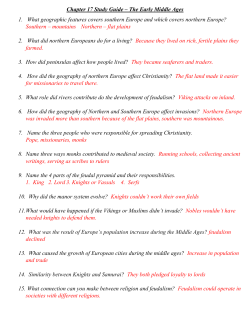
Central Point, OR. Knights of Columbus St. Augustine Council No
Central Point, OR. Knights of Columbus St. Augustine Council No. 11258 Vol. 21, No. 4, April 2015 Ryan Headley (left) enjoying the St. Patrick’s Day Dinner hosted by St. Augustine Council on March 17th. At right, Shelley and Jim Haught and Martial Henault. Over 130 parishioners attended the event that featured dinner, singing, and Bingo. BUSINESS MEETING: TUESDAY APRIL 7th Please plan to attend our monthly meeting this coming Tuesday, April 7th. The evening begins with Mass at 6:00 PM, followed in the Parish Center with a pizza dinner, and the Business Meeting at 7:00 p.m. Shepherd of the Vally Holy Week Schedule: Holy Thursday: Good Friday: Easter Vigil: 7:00 pm Bilingual 5:30 pm English 7:30 pm in Spanish 8:30 pm Bilingual LADIES’ APPRECIATION NIGHT: APRIL 21st Ladies’ Appreciation Dinner, Tuesday April 21st Knights and Ladies (as well as ‘unaccompanied’ knights!) are invited to attend our Annual Ladies Appreciation Night, Tuesday April 21 beginning at 6:30 p.m. at Wild River Brewing and Pizza Company, 2684 N. Pacific Hwy, Medford. Doug Smith will deliver this year’s appreciation. Ordering will be done off the menu and no advance reservations are needed. Since 2012, the Knights of Columbus, order-wide, have donated over $2.7 million and 3.8 million pounds of food to local food pantries, community food banks and soup kitchens. Special thanks to Bro. Chris Erno for coordinating this year’s event. Food for Families On Saturday and Sunday March 20-21st, St. Au- gustine Council Knights held an annual program to help alleviate hunger in our community, collecting 2000 lbs. of food for St. Vincent de Paul. Brothers Ron DeAvilla and Chris Erno collecting food for St. Vincent DePaul Society who graciously loaned us their truck for the occasion. Celebrations BIRTHDAYS: Members: Sam Barnum; Ralph Browning; Ron DeAvilla; Ed Dinius; John Garner; Terry Grogan; Dave Knouff; Scott Koester; Don Krolak; Mike Masters. Wives: Kristy Bodfield; Alice Mullaly; Megan Stillwell; Celina Tobias. WEDDING ANNIVERSARIES: Kristy and Mark Bodfield; Nancy and Jerry Bourgeois; Carmen and Frank Hernandez; Betty and Leon Stupfel; Ann and Carl Wieland. Jim Duman, Rest in Peace We were deeply saddened by the March 25th death of Brother James Peter Duman, whose funeral service, celebrated by Fr. Victor, took place at Shepherd of the Valley Church, Wednesday, March 26th. Born in 1929, in Scio, Oregon, Jim was the ninth of 14 chidren. He served in the US Navy during the Korean War, and worked in the lumber industry all his life, eventually becoming superintendent of Boise Cascade’s Medford facility, at the time the largest plywood producing mill in the world.He married his beloved Marilyn at Mt.Angel in 1954, and together they raised seven children. Jim Duman, became a Knight on his 18th in 1948 and later was a charter member of St. Augustine Council. He had been an active member of the council, regularly attending meetings, and taking the lead in carnival booths each year. Our prayers go out to his wife, Marilyn and family. Donations in Jim’s name can be made to Food and Friends, PO Box 3275, Central Point, OR 97502. Your editor would be grateful if you would help us improve the accuracy of these listings! Twenty leaders from the five councils of District 9 met with State Deputy Bob Kish on Saturday March 28 at Knights Hall in Medford to focus on building better councils. St. Augustine Council had five representatives in attendance. With fine hosting by the Medford Council, it was an excellent day in every way! Prayer Intentions Remember in your prayers Jack and Linda Kolaso, Ed Daniels, John Plunkett, and Gary Staats. Anyone who knows of other brother knights or family members in need are asked to contact Ron DeAvilla at 541- 4999217. Welcome New Members! CALENDAR OF EVENTS: Sun., April 5, Easter Tues., April 7 Business Meeting Tues., April 21 Ladies Appreciation Dinner Fri-Sun April 24-26 State Convention, Newport Tues., April 28 Officers’ Meeting Upcoming Exemplifications Sat., May 15 Sat., June 13, At our First Degree Exemplification March 3 we were happy to welcome brothers Jim Leffingwell (left)and Tony Casillas (right). 2nd and 3rd Degree Medford 4th Degree Grants Pass For more Council information visit our excellent website < www.KofC11258.org >.. You can find the newsletter clicking on the “Current Newsletter” link on the right at the bottom of the page. The Knights’ magnificent statue of the young Lafayette was well received by a war-ravaged France. The Metz Statue: When the Knights Spoke for America On a sultry August 5th evening in 1920 the transatlan- tic liner Leopoldina cast off from the New York docks amidst the sounds of a police band, sirens, and cheers. Aboard were 237 Knights, including 15 priests, bringing with them a giant American flag to use for unveiling an equestrian statue of the Revolutionary War hero, the Marquis de Lafayette. The ceremony was to take place on August 22nd in the northeastern French city of Metz, near the German border. From a distance it is difficult to appreciate the deep national stirrings in both the United States and France that this event occasioned. The idea of the monument had first surfaced at the 1919 National Knights of Columbus “Peace” Convention in Buffalo, New York where, following a powerful speech by a French High Commissioner, a resolution had been unanimously passed to memorialize the Franco-American wartime sacrifices with a statue of Lafayette. Within a short time, the Knights had raised $60,000 for the project, and at their National “Lafayette” Convention in August 1920, a model of the statue was displayed to the public in the foyer of the convention center, depicting the French officer as a young man with sword in hand setting out for America, “his face sharp-featured, intelligent, aristocratic.” But there was a backstory to the statue. In both countries, Catholics, through their loyalty to nation, had something to prove. The situation in France prior to the Great War was by far the most egregious. In 1905 the French Parliament had passed legislation transferring all Church property to state ownership, outlawed religious orders, and banned the teaching of religion in public schools. The Great War had provided Catholics an opportunity to assert themselves in the public forum. Supporting the war effort also allowed the Church to align itself with the traditionally Catholic officer corps of the French army, led by Ferdinand Foch, Grand Marshal of France and a devout Catholic. The choice of Metz, a city where the youthful Lafayette had made the decision to join the American Revolution, was also significant. The fortress town, the largest metropolitan center of Alsace-Lorraine, had been restored to France only one year earlier, after a repressive fortyyear occupation by Germany following the 1870 Franco-Prussian War. Its population was staunchly Catholic and since returning to French control had successfully resisted secularizing efforts of the central government. The Knights of Columbus were also highly regarded by the French government for their wartime work in France. During the two year period in which America had engaged in the conflict, Knights had distinguished themselves for support of the War effort, aiding in the collection of over $30,000,000 in contributions to take the lead in operating social and entertainment programs. By August 1919, the Knights were operating nearly one hundred servicemen’s clubs in France, under the motto “Everybody welcome, everything free.” The figure of Lafayette also seemed appropriate. He had served America as one of George Washington’s most trusted commanders, and had been responsible for bringing the French into the war. With the help of Thomas Jefferson, he had later drafted the core document of the French Revolution, the “Declaration of the Rights of Man and of the Citizen” (1789), and The three-ton statue, shown here on a Knights of Columbus truck at its foundry, had been shipped from New York three week prior to the departure of the delegates. Photograph is from a San Deigo, California newspaper. A Knights’ publication described the stature of The Marquis de Lafayette with“his face sharp-featured, intelligent, aristocratic.” had championed democratic revolutions in Greece, Poland, Italy, and South America. No figure in France was as closely identified with the ideals of democracy. For all of these reasons, both Marshall Foch and the French hierarchy were receptive to the Knights of Columbus’s offer. Not all sectors of the American Catholic community, however, saw the French hero in a positive light. Three years before coming to America, Lafayette, along with 100 other French officers, had joined a Masonic Lodge in Paris, an act that carried the penalty of excommunication – although at the time the stricture was only lightly enforced. But the issue had not gone away. In 1900 it had taken the personal approval of Pope Leo XIII for an American Archbishop to speak at the dedication of a similar statue of Lafayette in Paris. Two decades later, concerns again were raised criticizing the Knights for their endorsement of an “apostate general,” “ and a “renegade Catholic.” One priest complained that the Knights of Columbus were showing “ridiculous eagerness to prove [themselves] patriotic.” Elements of the German community seemed particularly unhappy. Defending the decision, the Supreme Secretary replied that the statue was intended to “express appreciation of the aid and assistance given by France to the struggling colonies” and not “to glorify Lafayette as a Catholic.” The French, however, welcomed the large delegation with open arms. Upon the group’s arrival at the seaport of La Havre on August 15th, it was whisked through customs and taken by special train to Paris to celebrate Mass at the Cathedral of Notre Dame with the Cardinal Archbishop. From Paris they traveled by train and automobile to the battlefields of Northern France where the countryside had been ravaged by war. “We passed through at least twenty small settlements or towns,” a delegate wrote, “many of them entirely destroyed, others partially ruined, while still others were deserted.” Hundreds of thousands of trees had been destroyed, many of them by poison gases and chemicals. At every side were cemeteries. America’s loss of 53,000 combatants was paled in comparison to the 1.3 million military deaths that the French had suffered. The members of the American delegation were deeply moved by the great number of black-dressed widows shouting “Vive l’Amerique!” as tears ran down their faces. Arriving at Metz on the afternoon of August 21, members of the group found the city festooned Metz was a fiercely Catholic City recently liberated from 40 years of German occupation when the statue was dedicated. A book-length account of the pilgrimage published in 1921 depicts a knight wearing a crusaders cross traveling through a barren land. Honoring the war dead was an important aspect of this pilgrimage. with American and French flags. On their way to a grand banquet attended by the Premier of France, they were cheered by enthusiastic crowds. The next morning, at a Solemn Memorial Mass honoring the dead of both countries Foch joined the Knights in receiving Communion. The dignitaries were then conveyed by automobile to the courtyard of the Palace of Justice for the dedication ceremony of the statue. Uncovering the statue, Supreme Knight James A. Flaherty recalled the oft-quoted General Pershing’s words, “ Lafayette we are here,” and to the delight of the huge crowd, then added: “Lafayette We Are still Here!” Aircraft flew overhead dropping flags and flowers. For the first time in fifty years the bells of the Cathedral were rung, and five thousand French troops paraded past. An account of the dedication of the statue appeared the next day on the front page of the New York Times, and in other newspapers across the United States. For twenty years, the statue stood as an el- oquent tribute to the internationalism and high mindedness of the Knights of Columbus in the period immediately after the Great War. Though the values symbolized by Lafayette remained, the statue would not survive. In 1940 German forces once again occupied Metz, and soon thereafter the statue and its artwork were destroyed. Larry Mullaly Insurance Corner complish it if you write it down. Second, resolve to have an expert look at your finances. I recommend that you have a team of experts help you, and I would love to be the first you sit with. Let’s schedule some time to meet together, and I, your professional Knights of Columbus insurance agent, will provide an “insurance check-up” (at no cost!) that will evaluate any gaps in your family’s life insurance protection. Now might be the perfect time to fill those gaps, not later. Keep in mind that unlike many other products, you don’t just need money to obtain life insurance; you also need good health, and no one knows when your health could change. Did I mention my check-up is free of charge? When was the last time you received something for free that could provide value to you and your family for generations? Call me today. Jim Walton Field Agent 541-961-1649 jim.walton@kofc.org Insurance Check-Up for 2015 Where did 2014 go? It seems like it was summer yes- terday and Easter was last week. I hope you and your family had a great finish to 2014. Now, the first quarter of 2015 is flying by. Hopefully, you’ve established a few goals for this year. I’ve learned a great tip regarding resolutions. First, write them down. It’s not too late if you haven’t already done this. Commit your goals to paper and post it someplace you will see it often. Writing down a goal is the first step towards achieving it. It may not make sense at first, but I’m sure you have heard stories of the success this simple task can bring. Whether your goal is to exercise more, give more to charity, read more or watch less television, you’re more likely to ac- Behind the scenes: Ed Daniels and a large group of knights and ladies set up the hall for the annual parish Seder Meal, March 24th. Respecting Life in All Its Stages T he 1,000 days between a woman’s pregnancy and her child’s 2nd birthday offer a unique window of opportunity to shape healthier and more prosperous futures. The right nutrition during this 1,000 day window can have a profound impact on a child’s ability to grow, learn, and rise out of poverty. It can also shape a society’s long-term health, stability and prosperity. The Archdiocese of Oregon in partnership with the Catholic Charities and the Portland Mother and Child Education Center are sponsoring daily webcasts for a thousand days of the program, beginning March 22, 2015. The well-produced audio programs can be accessed at www.archdpdx.org.
© Copyright 2025









